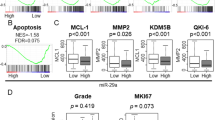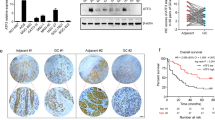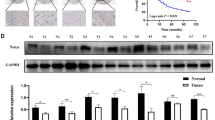Abstract
The dismal outcome of gastric cancer patients highlights the need for diagnostic biomarkers and effective therapeutic targets, such as microRNAs. We sought to discover microRNAs involved in gastric cancer, and to elucidate their downstream target mechanisms. Both cultured gastric epithelial cells (HFE145 and NCI-N87) and primary human gastric tissues (31 non-neoplastic stomach (NS) and 25 gastric carcinomas (GC)) were studied. MicroRNA microarrays and quantitative RT–PCR were applied to discover and verify differentially expressed microRNAs. in vitro cell migration and invasion, cell proliferation, cell cycle and apoptosis assays were executed to elucidate biological effects of microRNA-192 and -215. Western blotting and luciferase assays were performed to confirm direct messenger RNA targeting by microRNA-192 and -215. MicroRNA microarray analyses revealed that 25 and 20 microRNAs were upregulated and downregulated in GC vs NS, respectively. Expression levels of both microRNA-192 and -215 were significantly higher in GC than in NS (P<0.05). Luciferase assays suggested that microRNA-215 inhibits activated leukocyte cell adhesion molecule (ALCAM) expression at the posttranscriptional level. In addition, expression levels of ALCAM were significantly lower in GC than in NS. Mimics and inhibitors, respectively, of microRNA-192 or -215 exerted no effect on cell cycle or apoptosis in the immortalized normal gastric cell line HFE145 or the gastric cancer cell line NCI-N87. However, mimics of microRNA-192 or -215 significantly increased growth rates in HFE145 cells, whereas inhibitors of microRNA-192 or -215 caused significant decreases in growth rates in NCI-N87 cells. ALCAM knockdown by an ALCAM-specific siRNA significantly increased cell growth in HFE145 cells. Both transfection of mimics of microRNA-192 or -215 and ALCAM knockdown by an ALCAM-specific siRNA significantly increased the migration of HFE145 cells. In conclusion, in gastric cancer, both microRNA-192 and -215 are overexpressed in vivo and exert cell growth and migration-promoting effects in vitro, thus representing potential microRNAs with a role in cancer in the human stomach.
This is a preview of subscription content, access via your institution
Access options
Subscribe to this journal
Receive 50 print issues and online access
$259.00 per year
only $5.18 per issue
Buy this article
- Purchase on Springer Link
- Instant access to full article PDF
Prices may be subject to local taxes which are calculated during checkout





Similar content being viewed by others

References
Adiseshaiah P, Lindner DJ, Kalvakolanu DV, Reddy SP . (2007). FRA-1 proto-oncogene induces lung epithelial cell invasion and anchorage-independent growth in vitro, but is insufficient to promote tumor growth in vivo. Cancer Res 67: 6204–6211.
Agarwal R, Mori Y, Cheng Y, Jin Z, Olaru AV, Hamilton JP et al. (2009). Silencing of claudin-11 is associated with increased invasiveness of gastric cancer cells. PLoS One 4: e8002.
Ando T, Yoshida T, Enomoto S, Asada K, Tatematsu M, Ichinose M et al. (2009). DNA methylation of microRNA genes in gastric mucosae of gastric cancer patients: its possible involvement in the formation of epigenetic field defect. Int J Cancer 124: 2367–2374.
Bartel DP . (2004). MicroRNAs: genomics, biogenesis, mechanism, and function. Cell 116: 281–297.
Braun CJ, Zhang X, Savelyeva I, Wolff S, Moll UM, Schepeler T et al. (2008). p53-Responsive micrornas 192 and 215 are capable of inducing cell cycle arrest. Cancer Res 68: 10094–10104.
Carbone M, Rizzo P, Grimley PM, Procopio A, Mew DJ, Shridhar V et al. (1997). Simian virus-40 large-T antigen binds p53 in human mesotheliomas. Nat Med 3: 908–912.
Georges SA, Biery MC, Kim SY, Schelter JM, Guo J, Chang AN et al. (2008). Coordinated regulation of cell cycle transcripts by p53-Inducible microRNAs, miR-192 and miR-215. Cancer Res 68: 10105–10112.
Guo J, Miao Y, Xiao B, Huan R, Jiang Z, Meng D et al. (2009). Differential expression of microRNA species in human gastric cancer versus non-tumorous tissues. J Gastroenterol Hepatol 24: 652–657.
Jemal A, Siegel R, Ward E, Murray T, Xu J, Smigal C et al. (2006). Cancer statistics, 2006. CA Cancer J Clin 56: 106–130.
Jemal A, Siegel R, Ward E, Murray T, Xu J, Thun MJ. . (2007). Cancer statistics, 2007. CA Cancer J Clin 57: 43–66.
Jezierska A, Motyl T . (2009). Matrix Metalloproteinase-2 involvement in breast cancer progression: a mini-review. Med Sci Monit 15: RA32–RA40.
Jezierska A, Olszewski WP, Pietruszkiewicz J, Olszewski W, Matysiak W, Motyl T . (2006). Activated Leukocyte Cell Adhesion Molecule (ALCAM) is associated with suppression of breast cancer cells invasion. Med Sci Monit 12: BR245–BR256.
Khushalani N . (2008). Cancer of the esophagus and stomach. Mayo Clin Proc 83: 712–722.
Kim JH, Takahashi T, Chiba I, Park JG, Birrer MJ, Roh JK et al. (1991). Occurrence of p53 gene abnormalities in gastric carcinoma tumors and cell lines. J Natl Cancer Inst 83: 938–943.
Kim YK, Yu J, Han TS, Park SY, Namkoong B, Kim DH et al. (2009). Functional links between clustered microRNAs: suppression of cell-cycle inhibitors by microRNA clusters in gastric cancer. Nucleic Acids Res 37: 1672–1681.
Kimura Y, Noguchi T, Kawahara K, Kashima K, Daa T, Yokoyama S . (2004). Genetic alterations in 102 primary gastric cancers by comparative genomic hybridization: gain of 20q and loss of 18q are associated with tumor progression. Mod Pathol 17: 1328–1337.
Kristiansen G, Pilarsky C, Wissmann C, Stephan C, Weissbach L, Loy V et al. (2003). ALCAM/CD166 is up-regulated in low-grade prostate cancer and progressively lost in high-grade lesions. Prostate 54: 34–43.
Li Z, Zhan W, Wang Z, Zhu B, He Y, Peng J et al. (2006). Inhibition of PRL-3 gene expression in gastric cancer cell line SGC7901 via microRNA suppressed reduces peritoneal metastasis. Biochem Biophys Res Commun 348: 229–237.
Lytle JR, Yario TA, Steitz JA . (2007). Target mRNAs are repressed as efficiently by microRNA-binding sites in the 5′ UTR as in the 3′ UTR. Proc Natl Acad Sci USA 104: 9667–9672.
Motoyama K, Inoue H, Nakamura Y, Uetake H, Sugihara K, Mori M . (2008). Clinical significance of high mobility group A2 in human gastric cancer and its relationship to let-7 microRNA family. Clin Cancer Res 14: 2334–2340.
Noguchi T, Wirtz HC, Michaelis S, Gabbert HE, Mueller W . (2001). Chromosomal imbalances in gastric cancer. Correlation with histologic subtypes and tumor progression. Am J Clin Pathol 115: 828–834.
Ofori-Acquah SF, King JA . (2008). Activated leukocyte cell adhesion molecule: a new paradox in cancer. Transl Res 151: 122–128.
Orom UA, Nielsen FC, Lund AH . (2008). MicroRNA-10a binds the 5′UTR of ribosomal protein mRNAs and enhances their translation. Mol Cell 30: 460–471.
Petrocca F, Visone R, Onelli MR, Shah MH, Nicoloso MS, de Martino I et al. (2008). E2F1-regulated microRNAs impair TGFbeta-dependent cell-cycle arrest and apoptosis in gastric cancer. Cancer Cell 13: 272–286.
Rosso O, Piazza T, Bongarzone I, Rossello A, Mezzanzanica D, Canevari S et al. (2007). The ALCAM shedding by the metalloprotease ADAM17/TACE is involved in motility of ovarian carcinoma cells. Mol Cancer Res 5: 1246–1253.
Shi XB, Tepper CG, White RW . (2008). Cancerous miRNAs and their regulation. Cell Cycle 7: 1529–1538.
Song B, Wang Y, Kudo K, Gavin EJ, Xi Y, Ju J . (2008). miR-192 Regulates dihydrofolate reductase and cellular proliferation through the p53-microRNA circuit. Clin Cancer Res 14: 8080–8086.
Swart GW . (2002). Activated leukocyte cell adhesion molecule (CD166/ALCAM): developmental and mechanistic aspects of cell clustering and cell migration. Eur J Cell Biol 81: 313–321.
Tsai NP, Lin YL, Wei LN . (2009). MicroRNA mir-346 targets the 5′-untranslated region of receptor-interacting protein 140 (RIP140) mRNA and up-regulates its protein expression. Biochem J 424: 411–418.
Tsukamoto Y, Uchida T, Karnan S, Noguchi T, Nguyen LT, Tanigawa M et al (2008). Genome-wide analysis of DNA copy number alterations and gene expression in gastric cancer. J Pathol 216: 471–482.
van Kempen LC, Meier F, Egeblad M, Kersten-Niessen MJ, Garbe C, Weidle UH et al. (2004). Truncation of activated leukocyte cell adhesion molecule: a gateway to melanoma metastasis. J Invest Dermatol 122: 1293–1301.
Volinia S, Calin GA, Liu CG, Ambs S, Cimmino A, Petrocca F et al. (2006). A microRNA expression signature of human solid tumors defines cancer gene targets. Proc Natl Acad Sci USA 103: 2257–2261.
Wang Z, He YL, Cai SR, Zhan WH, Li ZR, Zhu BH et al. (2008). Expression and prognostic impact of PRL-3 in lymph node metastasis of gastric cancer: its molecular mechanism was investigated using artificial microRNA interference. Int J Cancer 123: 1439–1447.
Xia L, Zhang D, Du R, Pan Y, Zhao L, Sun S et al. (2008). miR-15b and miR-16 modulate multidrug resistance by targeting BCL2 in human gastric cancer cells. Int J Cancer 123: 372–379.
Zhou X, Duan X, Qian J, Li F . (2009). Abundant conserved microRNA target sites in the 5′-untranslated region and coding sequence. Genetica 137: 159–164.
Author information
Authors and Affiliations
Corresponding author
Ethics declarations
Competing interests
The authors declare no conflicts of interest.
Additional information
Supplementary Information accompanies the paper on the Oncogene website
Supplementary information
Rights and permissions
About this article
Cite this article
Jin, Z., Selaru, F., Cheng, Y. et al. MicroRNA-192 and -215 are upregulated in human gastric cancer in vivo and suppress ALCAM expression in vitro. Oncogene 30, 1577–1585 (2011). https://doi.org/10.1038/onc.2010.534
Received:
Revised:
Accepted:
Published:
Issue Date:
DOI: https://doi.org/10.1038/onc.2010.534
Keywords
This article is cited by
-
Histone methyltransferase SET8 is regulated by miR-192/215 and induces oncogene-induced senescence via p53-dependent DNA damage in human gastric carcinoma cells
Cell Death & Disease (2020)
-
Vasodilator-stimulated phosphoprotein (VASP), a novel target of miR-4455, promotes gastric cancer cell proliferation, migration, and invasion, through activating the PI3K/AKT signaling pathway
Cancer Cell International (2018)
-
Inhibition of the miR-192/215–Rab11-FIP2 axis suppresses human gastric cancer progression
Cell Death & Disease (2018)
-
RETRACTED ARTICLE: Decreased expression of miR-939 contributes to chemoresistance and metastasis of gastric cancer via dysregulation of SLC34A2 and Raf/MEK/ERK pathway
Molecular Cancer (2017)
-
Alternative new mesenchymal stem cell source exerts tumor tropism through ALCAM and N-cadherin via regulation of microRNA-192 and -218
Molecular and Cellular Biochemistry (2017)


